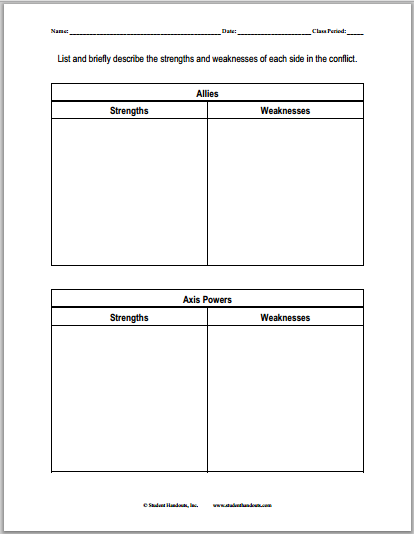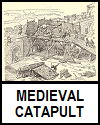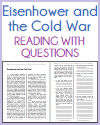Students are asked to list the strengths and weaknesses of the Allies and the Axis during World War II in this blank chart. Click here to print. Answers will vary.
Strengths and Weaknesses of the Axis Powers:
Strengths:
- Early Military Superiority: The Axis powers, particularly Germany, had advanced and well-coordinated military strategies, exemplified by blitzkrieg tactics that led to rapid conquests.
- Technological Innovations: They developed sophisticated weaponry and technology, including advanced tanks (Panzers), aircraft (Luftwaffe), and the V-2 rocket.
- Strategic Alliances: The Axis powers initially secured critical alliances, like the Tripartite Pact between Germany, Italy, and Japan, allowing them to coordinate efforts across Europe, Africa, and Asia.
Weaknesses:
- Overextended Supply Lines: As the Axis expanded their territories, maintaining supply lines became increasingly difficult, leading to logistical challenges.
- Resource Shortages: The Axis powers faced significant resource constraints, particularly oil, which hampered their sustained military efforts.
- Ideological Rigidities: The Axis' totalitarian regimes and ideological inflexibility often led to strategic blunders and alienated potential allies or occupied populations.
Strengths and Weaknesses of the Allies:
Strengths:
- Economic and Industrial Capacity: The Allies, especially the United States, had vast industrial resources and the ability to produce large quantities of war materials, vehicles, and weapons.
- Geographical Advantage: The Allies controlled significant territories, including the British Empire, the Soviet Union, and later the United States, providing strategic bases and diverse fronts.
- Technological and Intelligence Superiority: Allied advancements in technology, such as radar, the breaking of the Enigma code, and the development of the atomic bomb, provided significant advantages.
Weaknesses:
- Initial Disadvantages: Early in the war, the Allies suffered significant defeats and territorial losses, exemplified by the fall of France and initial setbacks in the Pacific.
- Coordination Challenges: The diverse political systems and military strategies among the Allied powers sometimes led to coordination and strategic disagreements.
- Casualty Rates: The Allies, particularly the Soviet Union, endured extremely high casualties and destruction, which strained their military and civilian morale.
Overall, while the Axis powers had early advantages in military strategy and technology, their weaknesses in resources, logistics, and strategic flexibility ultimately led to their downfall. Conversely, the Allies' industrial strength, technological innovations, and extensive resources enabled them to overcome initial setbacks and achieve victory.
|













